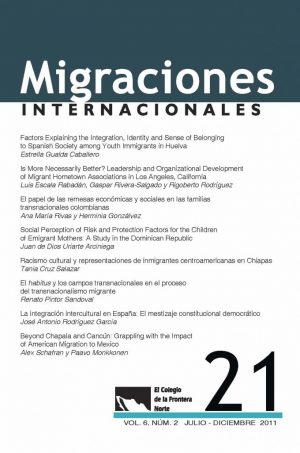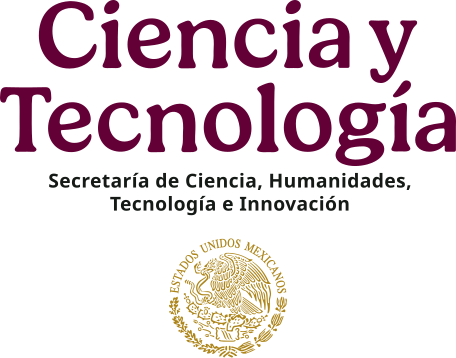Factors Explaining the Integration, Identity and Sense of Belonging to Spanish Society among Youth Immigrants in Huelva
DOI:
https://doi.org/10.17428/rmi.v6i21.751Keywords:
second generation immigrants, youth, social integration, cultural identity, SpainAbstract
In this article on the social processes of integration in adolescents and youth, we describe and explain the factors which, in a representative sample of 413 immigrant adolescents in Huelva, Spain, are linked to having a sense of belonging to Spain. Approximately fi fty percent of those interviewed reported a sense of belonging to Spain, although the degree of belonging to this country was lower or non-existent in other cases. This paper attempts to delimit the elements that largely explain the degree of the sense of belonging to a country, which is crucial to understanding the processes of identifi cative integration.
We found several variables linked to the sense of belonging to Spain: life satisfaction, structural opportunities perceived in Spain, orientation towards the Spanish language (monolingual or bilingual), multiple territorial identifi cation, participation in Spanish celebrations and activities, and trust in Spanish people.
Factores explicativos de la integración, identidad y pertenencia a la sociedad mespañola de jóvenes inmigrantes en Huelva
Resumen
En este artículo, enmarcado en los procesos de integración de adolescentes y jóvenes inmigrantes, describimos y explicamos los factores que, en una muestra representativa de 413 menores inmigrantes en Huelva y provincia, se encuentran ligados al hecho de sentirse pertenecientes a España. La mitad de los entrevistados declararon sentirse parte de este país, mientras que el grado de pertenencia expresado fue intermedio o nulo en el resto de los casos. Este trabajo trata de deslindar los elementos que en mayor medida contribuyen a explicar el grado de sentimiento de pertenencia al país, siendo conscientes de la importancia que esto tiene para entender los procesos de integración identificativa.
Las principales variables que se encontraron asociadas al sentimiento de pertenencia a España fueron la satisfacción con la vida, las oportunidades estructurales percibidas en este país, la orientación hacia el idioma nacional (monolingüismo y bilingüismo), una identificación territorial múltiple u orientada a España, la participación en celebraciones y actividades del país, así como la confianza hacia los españoles.
References
Arango Vila-Belda, J., 1999, “Becoming a Country of Immigration
at the End of the xxth Century: The Case of Spain”, in R.
King, G. Lazaridis and C. Tsardanidis, eds., Eldorado or Fortress?
Migration in Southern Europe, London, MacMillan Press,
pp. 253-276.
Barrera, M., 1980, “Method for the Assessment of Social Support.
Network in Community Survey Research”, Connections,
num. 3, pp. 8-13.
Bellón Sameño, J. A. et al., 1996, “Validez y fiabilidad del cuestionario
social funcional Duke-unc-11”, Atención Primaria, vol.
, num. 4, pp. 153-163.
Bhimji, F., 2008, “Cosmopolitan Belonging and Diaspora: Second-
Generation British Muslim Women Travelling to South
Asia”, Citizenship Studies, vol. 12, num. 4, pp. 413-427.
Bodenhausen, G. V., 2010, “Diversity in the Person, Diversity in
the Group: Challenges of Identity Complexity for Social Perception
and Social Interaction”, European Journal of Social Psychology,
vol. 40, num. 1, pp. 1-16.
Brettell, C. B. and F. Nibbs, 2009, “Lived Hybridity: Second-
Generation Identity Construction through College Festival”,
Identities: Global Studies in Culture and Power, vol. 16, num.
, pp. 678-699.
Butcher, M., 2008, “fob Boys, vcs and Habibs: Using Language
to Navigate Difference and Belonging in Culturally Diverse
Sydney”, Journal of Ethnic and Migration Studies, vol. 34, num.
, pp. 371-387.
Cara, O., 2010, “Lives on the Border: Language and Culture in
the Lives of Ethnic Russian Women in Baltinava, Latvia”, Nationalities
Papers, vol. 38, num. 1, pp. 123-142.
Cea D’Ancona, M. A. and M. S. Vallés Martínez, 2009, Evolución
del racismo y la xenofobia en España. Informe 2008, Madrid,
Ministerio de Trabajo e Inmigración.
Chávez-Reyes, C., 2010, “ ‘Starting at the Top’: Identifying and
Understanding Later Generation Chicano Students in Schools”,
Journal of Latinos and Education, vol. 9, num. 1, pp. 22-40.
Chow, Henry P. H., 2007, “Sense of Belonging and Life Satisfaction
among Hong Kong Adolescent Immigrants in Canada”,
Journal of Ethnic and Migration Studies, vol. 33, num. 3, pp.
-520.
Comisión de las Comunidades Europeas, 2005, “El nexo entre
migración y desarrollo: Algunas orientaciones concretas para
la cooperación entre la UE y los países en vías de desarrollo”,
in Europa. Síntesis de la legislación de la UE, Bruselas. Available
at <http://europa.eu/legislation_summaries/development/
sectoral_development_policies/l14166_es.htm> (last accessed
on July 5, 2006).
Comisión Europea, 2010, “Comunicación de la Comisión al Parlamento
Europeo y al Consejo. Plan de acción sobre los menores
no acompañados (2010-2014)”, Bruselas, sec(2010)534/
com(2010)213 final, May 6.
Consejería de Educación, 2007, Estadística de la educación en
Andalucía. Enseñanza secundaria. Alumnado extranjero. Curso
-2007, Sevilla, Junta de Andalucía.
Criado, M. J., 2001, La línea quebrada, Madrid, Consejo Económico
y Social.
Crul, M. and H. Vermeulen, 2003, “The Second Generation in
Europe”, International Migration Review, vol. 37, num. 4, pp.
-986.
Esser, H., 2009, “Pluralisierung oder Assimilation? Effekte der
Multiplen Inklusion auf die Integration von Migranten”, Zeitschrift
Fur Soziologie, vol. 38, num. 5, pp. 358-378.
European Social Survey, 2010, “Project Information”. Available
at <http://europeansocialsurvey.org> (last accessed on April 2,
.
fao, 2010, “Major Food and Agricultural Commodities and
Produc ers”, Food and Agricultural Organization of the United
Nations. Available at <http://www.fao.org/es/ess/top/
topproduction.html?lang=en&country=203&year=2005> (last
accessed on May 19, 2010).
Garland, J., and N. Chakraborti, 2006, “ ‘Race’, Space and Place:
Examining Identity and Cultures of Exclusion in Rural England”,
Ethnicities, vol. 6, num. 2, pp. 159-177.
Google, 2011, “Huelva, España”, map, Google Maps España/
Tele Atlas. Available at <http://maps.google.es/maps?oi=eu_
map&q=Huelva&hl=es> (last accessed on April 9, 2011).
Goza, F. and I. Ryabov, 2009, “‘Adolescents’ Educational Outcomes:
Racial and Ethnic Variations in Peer Network Importance”,
Journal of Youth and Adolescence, vol. 38, num. 9, pp.
-1279.
Gualda Caballero, E., 2007, “Segunda generación y adolescentes
y jóvenes inmigrantes: El caso de Huelva”, in E. Gualda Caballero
and I. Rodríguez Pascual, coords., Desarrollo global y
desarrollo local: Infancia y adolescencia en las migraciones internacionales, Madrid, Exlibris Ediciones, pp. 51-70.
Gualda Caballero, E., 2010, ed., La segunda generación de inmigrantes
en Huelva. Estudio HIJAI, Valencia, Diálogos-Red.
Gualda Caballero, E. and B. Schramkowski, 2007, “Procesos de
integración de jóvenes de origen extranjero pertenecientes a distintas
generaciones en España y Alemania”, Barcelona, in “ix
Congreso Español de Sociología: Poder, Cultura y Civilización
de la Sociedad Espa ñola”, Federación Española de Sociología,
September 13-15.
Guilamo-Ramos, V., 2009, “Maternal Influence on Adolescent
Self-Esteem, Ethnic Pride and Intentions to Engage in Risk
Behavior in Dominican and Puerto Rican Youth”, Prevention
Science, vol. 10, num. 4, pp. 366-375.
Instituto Estadístico de Andalucía, 2009, Padrón Municipal de
Andalucía, Sevilla, Junta de Andalucía.
Jackson, K. F., 2009, “Building Cultural Competence: A Systematic
Evaluation of the Effectiveness of Culturally Sensitive Interventions
with Ethnic Minority Youth”, Children and Youth
Services Review, vol. 31, num. 11, pp. 1192-1198.
Lam, V. and G. Smith, 2009, “African and Caribbean Adolescents
in Britain: Ethnic Identity and Britishness”, Ethnic and
Racial Studies, vol. 32, num. 7, pp. 1248-1270.
López Rodrigo, J. M., 2007, “La segunda generación no es inmigrante”,
Documentación Social, num. 147, pp. 129-146.
Lubbers, Miranda J., J. L. Molina and C. McCarty, 2007, “Personal
Networks and Ethnic Identifications”, International Sociology,
vol. 22, num. 6, pp. 721-741.
Ministerio de Medio Ambiente y Medio Rural y Marino, 2009,
Anuario de estadística. Ministerio de Medio Ambiente y Medio
Rural y Marino 2008, Madrid, Gobierno de España, Secretaría
General Técnica, Subdirección General de Estadística. Available
at <http://www.mapa.es/estadistica/pags/anuario/2008/
Anuario_2008.pdf> (last accessed on May 20, 2010).
Moreno, M., 2008, “Lessons of Belonging and Citizenship among
hijas/os de inmigrantes mexicanos”, Social Justice, vol. 35, num.
, pp. 50-75.
Murtuja, B., 2006, “The Bubble of Diaspora: Perpetuating ‘us’
through Sacred Ideals”, Critical Studies, num. 28, pp. 293-311.
Pascual de Sans, A., V. Miguel and M. Solana, 2007, Redes sociales
de apoyo. La inserción de la población extranjera, Bilbao, Fundación
bbva.
Peguero, A. A., 2009, “Victimizing the Children of Immigrants:
Latino and Asian-American Student Victimization”, Youth &
Society, vol. 41, num. 2, pp. 186-208.
Portes, A. and R. G. Rumbaut, 2006, Immigrant America. A Portrait,
Berkeley, The California University Press.
Portes, A. and P. Fernández-Kelly, 2008, “No Margin for Error:
Educational and Occupational Achievement among Disadvantaged
Children of Immigrants”, The Annals of the American
Academy of Political and Social Science, num. 620, pp. 12-36.
Rumbaut, R., 2008, “The Coming of the Second Generation:
Im migration and Ethnic Mobility in Southern California”,
The Annals of the American Academy of Political and Social Science,
num. 620, pp. 196-236.
Sassenberg, K. and C. Matschke, 2010, “The Impact of Exchange
Programs on the Integration of the Hostgroup into the Selfconcept”,
European Journal of Social Psychology, vol. 40, num.
, pp. 148-159.
Save the Children [documento de trabajo], 2003, Menores no
acom pañados. Informe sobre la situación de los menores no acom -
pañados en España, num. iv, Madrid, Save the Children. Avail -
able at <http://www.savethechildren.es/docs/Ficheros/33/
Informe%20Menores%20no%20Acompaados.pdf> (last accessed
on March 3, 2010).
Secretaría de Estado de Inmigración y Emigración, 2009, “Extranjeros
con certificado de registro o tarjeta de residencia en vigor
y extranjeros con autorización de estancia por estudios en vigor a
de septiembre de 2009”, quarterly report, Madrid, Gobierno
de España, Ministerio de Trabajo e Inmigración. Available
at <http://extranjeros.mtin.es/es/InformacionEstadistica/
Informes/Extranjeros30Septiembre2009/index.html> (last
accessed on March 11, 2010).
Simon, P., 2003, “France and the Unknown Second Generation:
Preliminary Results on Social Mobility”, International Migration
Review, vol. 37, num. 4, pp. 1091-1119.
Simon, P., 2005, “Une question de la seconde generation en
Fran ce”, Seminaire Espace de Recherche de Confrontation
de Developpements de Noveaux Concepts. Available at
<http://seminaire.samizdat.net/UNE-QUESTION-DELASECONDE,
html> (last accessed on March 14, 2006).
Suárez, L., 2004, “Niños entre fronteras: Migración de menores
no acompañados en el Mediterráneo occidental”, Migración y
Desarrollo, num. 002, April, pp. 35-48.
Suárez-Orozco, C., J. Rhodes and M. Milburn, 2009, “Unraveling
the Immigrant Paradox: Academic Engagement and
Disengagement among Recently Arrived Immigrant Youth”,
Youth & Society, vol. 41, num. 2, pp. 151-185.
Thomson, M. and M. Crul, 2007, “The Second Generation in
Europe and the United States: How Is the Transatlantic Debate
Relevant for Further Research on the European Second
Generation?”, Journal of Ethnic and Migration Studies, vol. 33,
num. 7, pp. 1025-1041.
Trew, J. D., 2009, “Migration in Childhood and Its Impact on
National Identity Construction among Migrants from Northern
Ireland”, Irish Studies Review, vol. 17, num. 3, pp. 297-314.
Tsolidis, G. and V. Pollard, 2009, “Being a ‘Wog’ in Melbourne:
Young People’s Self-Fashioning through Discourses of Racism”,
Discourse: Studies in the Cultural Politics of Education, vol. 30,
num. 4, pp. 427-442.
Ueno, K., 2009, “Same-Race Friendships and School Attachment:
Demonstrating the Interaction Between Personal Network and
School Composition”, Sociological Forum, vol. 24, num. 3, pp.
-537.
Vermeij, L., M. A. J. van Duijn and C. Baerveldt, 2009, “Ethnic
Segregation in Context: Social Discrimination among Native
Dutch Pupils and their Ethnic Minority Classmates”, Social
Networks, vol. 31, num. 4, pp. 230-239.
Downloads
Published
Issue
Section
License
Authors publishing work in this journal agree to the following conditions:
Authors retain copyright and assign first publication rights to the journal Migraciones Internacionales (MI), with the texts registered under an Attribution-NonCommercial-NoDerivatives 4.0 International Creative Commons license (CC BY-NC-ND 4.0), which allows third parties to use published material provided they give credit to the authors and acknowledge this journal as the first publisher.
They authorize the reproduction, publication, translation, communication, and transmission of their paper and all accompanying material, publicly and in any form and by any means; its public distribution in as many copies as required; and public communication thereof in any form, including making it available to the public through electronic means or any other technology, and solely for dissemination and scientific, cultural, and non-commercial purposes.
Authors may enter into further independent contractual agreements for the non-exclusive distribution of the version of the paper published in this journal (for instance, to include it in an institutional repository or personal webpage, or publish it in a book), provided it is not for commercial purposes and they clearly state that the work was first published in Migraciones Internacionales (MI) [and add the corresponding bibliographical record: Author/s (Year). Title of paper. Migraciones Internacionales, volume (number), pp. doi: xxxx].
To that end, authors must submit the form assigning ownership of first publication rights, duly completed and signed. This document is to be uploaded in PDF format as a complementary file on the OJS platform.
This work is released under an Attribution-NonCommercial-NoDerivatives 4.0 International Creative Commons license (CC BY-NC-ND 4.0)..













